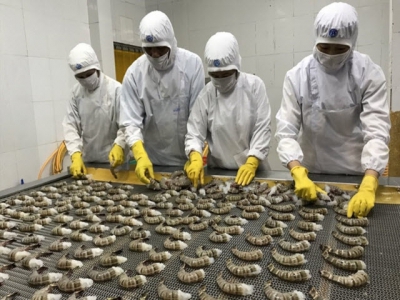Vietnamese shrimp increases market share in the US

The challenges facing Vietnam's shrimp sector in the last months this year will be the competitions from two shrimp powerhouses, India and Ecuador.
The increase in consumption demand in the US opens up opportunities for shrimp export nations such as Vietnam.
Despite of intense competence, Vietnamese shrimp takes a market share of 7.9% on the total import amount of the US in the first 7 months this year. That means an increase of 1% over the same period of 2020.
The US imported 518,000 tons of shrimp in the first 7 months of 2021, says the National Marine Fisheries Service (NMFS). The import volume valued US$ 5.25 billion, increased 27.4% in quantity and 36.9% in value over the same period of 2020.
In July alone, the import volume reached 83,000 tons, valued US$ 904.52 million,increased 13.8% in quantity and 30.7% in value over the same period of 2020.
The increase in consumption demand in the US opens up opportunities for shrimp export nations such as Vietnam, and results in sharp growth in comparison to 2020.
The US market share for Vietnamese shrimp increased from 6.9% to 7.9% in the first 7 months this year. However, the increase was still below as that of Ecuador, as the South America nation saw a growth from 15.4% to 20.8%.
Another big export nation is India, which grabs a stable total supply to the US market.
Besides the US, the shrimp export sector also achieves growth in markets where Vietnam has signed a Free Trade Agreement (FTA). According to the Vietnam Association of Seafood Exporters and Producers (VASEP), shrimp exports to markets such as EVFTA and CPTPP grew by double digits.
According to the Department of Exports and Imports (under the Ministry of Industry and Trade), the demand for shrimps in the US in particular and all over the world in general will growing in the coming months by the end of 2021, as it coincides with some special occasions such as Christmas, New Year event, etc.
In addition, the US’s importers have discharged inventory shrimps, and they will buy a large volume to balance the supply. Retailers in the market of 300 million consumers also are looking for finished shrimps to stabilise the reserve up to the end of 1st quarter in 2022.
Demands for high value shrimp products such as large sized black tiger shrimp are likely to increase sharply. Black tiger shrimp is a favorite item of American families, a main dish at year end family parties. Large sized black tiger shrimp has long been Vietnam's strength in the US market. It is always seen as a product that can create opportunities for shrimp processing and exporting enterprises to regain growth, after being affected by social distancing, especially in the southern provinces and cities.
Opportunities do along with challenges. The challenges facing shrimp sector in the last months this year will be the competitions from two shrimp powerhouses, India and Ecuador.
These nations now see the US market a big chance as China has halted shirmp import to prevent intrusion of SARS-CoV-2 as the virus might has on the seafood. Some Ecuador enterprises face strict hygiene controls by Chinese authorities, and containers of frozen products from India get stuck at the border.
Like vietnam, India and Ecuador both are affected by the Covid-19 pandemic and will boost shrimp export to the US in the coming months to revive total export turnover of 2021.
Ecuador has the advantage of geography to others. Being near the US helps the nation easily transporting goods to the important market. Ecuador is improving its processing skills, especially deep processing. Previously, Ecuador only sold whole shrimp because there was shortage of labor, capital, and being at low level of technology. However, this country has found a way out by using female workers from neighboring countries to speed up the production chain.
India has speed up producing since the middle of September, when the price of shrimp materials increased and the Covid-19 infected cases slowed down. Having an abundant labors and strength in logistics, India poses a big challenge to Vietnam shrimp sector.
The competitive advantage of Vietnam shrimp sector is the abilities to process high value products such as steamed shrimp, peeled and deveined shrimp, serving the retail segment. This is also a potential market segment when the trend of seafood consumption at home in the US is increasing.
Vietnam’s companies are facing many difficulties and challenges to the other competitors, such as logistics, continuously increasing container rental prices, lack of empty containers and long shipping time. Some enterprises in Mekong delta have their own difficulties due to measures dealing with the pandemic like “3 at places”, “1 route - 2 destinations”, medical costs, Covid-19 testing and accommodation for workers.
Related news
 Most Vietnam’s seafood exported to the EU has certificates of origin
Most Vietnam’s seafood exported to the EU has certificates of origin The EU is one of the biggest exporting market of Vietnam’s seafood in recent years, says the Department of Exports and Imports
 Tra fish exports drastically drop due to Covid-19 social distancing
Tra fish exports drastically drop due to Covid-19 social distancing Pangasius export turnover in August 2021 decreased by 28.5 percent over the same period, it is expected to continue falling 30 percent year on year in September
 Tuna exports sharply dropped in August
Tuna exports sharply dropped in August Despite having had many months of continuous growth, Vietnam's tuna exports in August 2021 decreased significantly compared to the same period last year.